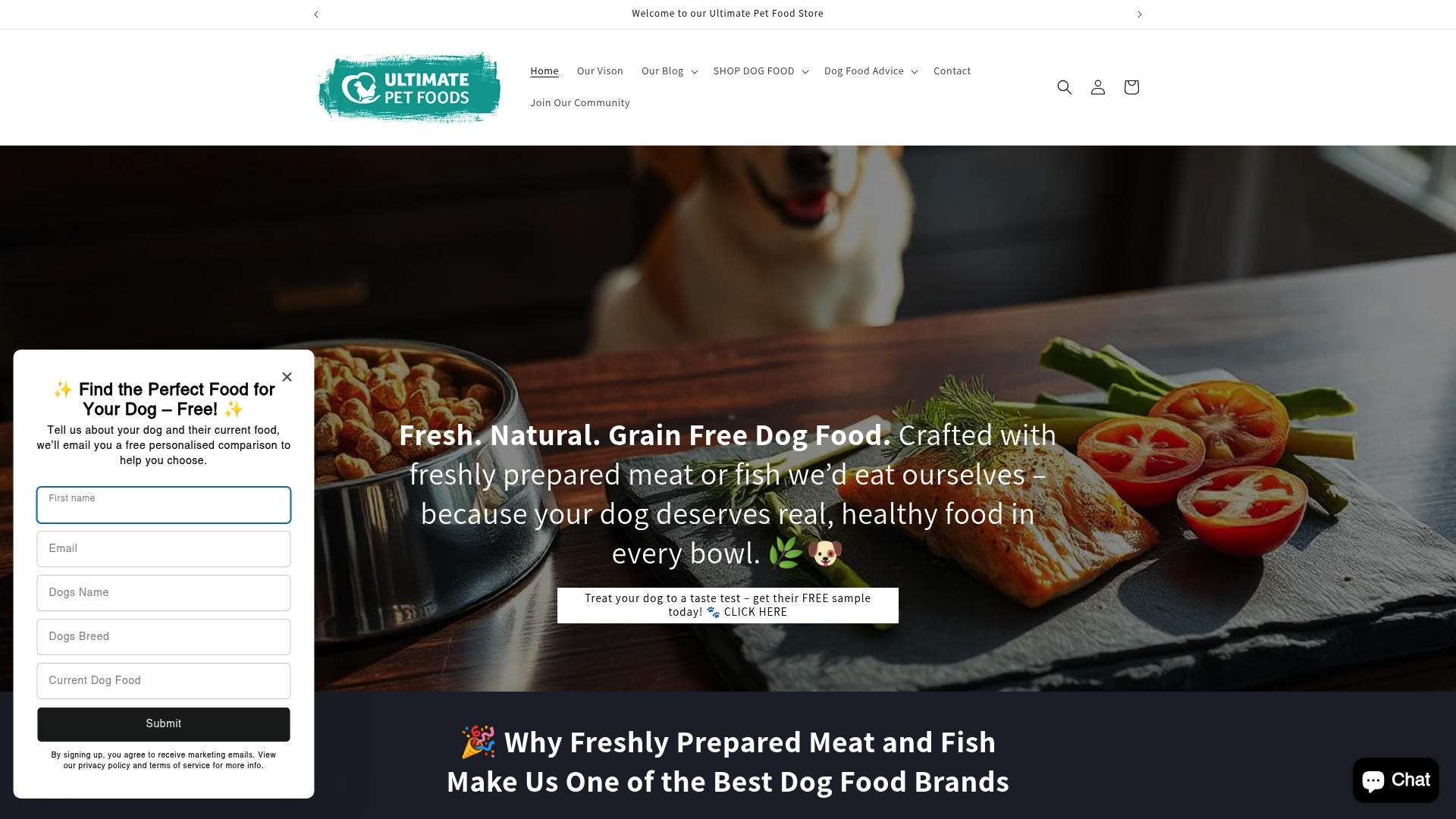
Understanding the Benefits of Fresh Dog Food for Your Pet
Share
Fresh dog food is shaking up the way people think about feeding their pets. Most commercial kibble is cooked at high temperatures that destroy nutrients and rely on preservatives, but fresh dog food stands out with whole, minimally processed ingredients that keep natural enzymes and nutrition locked in. You might expect high-tech packaging or wild flavor combos to be the star, but what really sets it apart is how much closer it comes to a dog’s natural diet. The science is already showing big gains for dogs who eat this way, and the results may surprise you.
Table of Contents
- What Is Fresh Dog Food And How Is It Different?
- Why Fresh Dog Food Matters For Canine Health
- How Fresh Ingredients Enhance Nutritional Value
- The Impact Of Fresh Dog Food On Specific Health Issues
- Key Concepts Behind Fresh Dog Food Nutrition
Quick Summary
| Takeaway | Explanation |
|---|---|
| Fresh dog food uses whole, natural ingredients | Unlike processed kibble, fresh dog food focuses on minimally processed ingredients that align with a dog’s natural diet. |
| Gentle cooking preserves nutrients | Fresh dog food is prepared with methods that retain essential nutrients and enzymes, enhancing overall food quality. |
| Higher bioavailability improves absorption | Fresh food allows better nutrient absorption, which benefits your dog’s health and energy levels. |
| Addresses specific health issues | Fresh diets can help mitigate allergies, digestive problems, and metabolic irregularities in dogs. |
| Veterinary support is critical for formulation | Professional guidance ensures balanced nutrition and ingredient quality in fresh dog food preparation. |
What is Fresh Dog Food and How is it Different?
Fresh dog food represents a revolutionary approach to canine nutrition that dramatically differs from traditional processed kibble and canned meals. Unlike mass-produced commercial pet foods that rely on high-heat processing and preservatives, fresh dog food focuses on whole, minimally processed ingredients that closely mimic a dog’s natural dietary needs.
The Fundamental Differences in Preparation
Traditional dog food manufacturing involves extensive processing that can significantly degrade nutritional value. Commercial kibble typically undergoes extrusion at extremely high temperatures, which can break down proteins, eliminate essential nutrients, and reduce overall food quality. In contrast, fresh dog food is prepared using gentle cooking methods that preserve the natural integrity of ingredients.
The key characteristics of fresh dog food include:

- Minimally processed whole food ingredients
- Carefully controlled cooking temperatures
- Higher moisture content
- Preservation of natural enzymes and nutrients
- No artificial preservatives or unnecessary fillers
Nutritional Profile and Quality
According to Tufts University Veterinary Nutrition, fresh dog food offers a more bioavailable and digestible nutrition profile. The careful selection and preparation of ingredients mean dogs receive higher quality protein sources, more complete amino acid profiles, and improved nutrient absorption.
While fresh dog food requires more careful formulation to ensure balanced nutrition, it represents a significant advancement in understanding canine dietary needs. By prioritizing whole food ingredients and gentle preparation methods, our approach to dog nutrition aims to support long-term health and vitality for your four-legged companion.
To clarify the primary distinctions between fresh dog food and traditional processed dog food, the following table compares their defining characteristics side by side.
| Feature | Fresh Dog Food | Traditional Dog Food (Kibble/Canned) |
|---|---|---|
| Ingredient Processing | Minimally processed, whole food ingredients | Highly processed, often refined ingredients |
| Cooking Method | Gentle cooking at lower temperatures | High-heat extrusion or canning |
| Nutrient Preservation | Retains more natural enzymes and vitamins | Nutrient loss due to heat and processing |
| Moisture Content | Higher moisture (resembles real food) | Lower moisture (dry or dense) |
| Additives/Preservatives | No artificial preservatives, fewer fillers | Reliance on synthetic preservatives/fillers |
| Nutritional Bioavailability | Higher, easier for dogs to absorb nutrients | Lower, reduced absorption |
| Alignment with Natural Diet | Closely mimics dog’s ancestral diet | Less aligned with natural feeding patterns |
Why Fresh Dog Food Matters for Canine Health
The connection between diet and overall health is profound for dogs, with fresh food offering significant advantages over traditional processed alternatives. Nutrition plays a critical role in determining a dog’s long-term wellness, energy levels, and potential to prevent chronic health conditions.
Nutritional Integrity and Bioavailability
Fresh dog food provides superior nutritional value through minimally processed ingredients that retain their natural enzyme structures and nutrient profiles. Unlike heavily processed kibble, which often loses critical nutritional components during manufacturing, fresh foods maintain higher bioavailability. This means dogs can more effectively absorb and utilize the nutrients present in their meals.
Key health benefits of fresh dog food include:
- Enhanced digestive function
- Improved immune system performance
- Better weight management
- More stable energy levels
- Reduced inflammation markers
Scientific Insights into Dietary Impact
According to research published in the journal Animals, fresh diets support healthier gut microbiota, which is fundamental to overall canine immune function. The study highlights how minimally processed foods can contribute to long-term health outcomes by providing more natural, easily digestible nutrients.
Veterinary nutritionists increasingly recognize that selecting high-quality ingredients is crucial for preventing diet-related health issues. Fresh dog food represents a proactive approach to nutrition, focusing on whole ingredients that support cellular health, muscle maintenance, and metabolic functions.
How Fresh Ingredients Enhance Nutritional Value
Fresh ingredients represent more than just a trendy approach to dog nutrition - they are a scientifically validated method of delivering superior nutritional content directly to your canine companion. Whole food ingredients provide complex nutritional profiles that processed foods simply cannot replicate, offering comprehensive benefits beyond basic caloric intake.
Nutrient Preservation and Bioavailability
When ingredients are minimally processed, they retain their natural molecular structures, enzymatic compositions, and intrinsic nutritional qualities. Heat-sensitive nutrients like certain vitamins, amino acids, and minerals remain intact, ensuring maximum absorption and utilization by your dog’s metabolic systems. This preservation of nutritional integrity means dogs receive more complete and potent nourishment from each meal.
Key advantages of fresh ingredient nutritional profiles include:
- Higher concentration of active enzymes
- More complete protein amino acid chains
- Enhanced vitamin and mineral preservation
- Greater nutrient density per serving
- Reduced nutritional degradation
Scientific Understanding of Ingredient Quality
According to research published in the journal Animals, fresh meat-based diets demonstrate significantly higher levels of bioavailable nutrients compared to traditional extruded kibble. These diets support improved nutrient digestibility, which translates to better overall metabolic health for dogs.
Veterinary nutritionists emphasize that understanding ingredient quality is crucial. Fresh ingredients offer a holistic approach to nutrition, providing not just calories, but a complex network of supportive compounds that contribute to long-term health, robust immune function, and optimal physiological performance.
The Impact of Fresh Dog Food on Specific Health Issues
Fresh dog food represents more than a dietary trend - it is a targeted nutritional approach addressing specific canine health challenges.
Below is a table summarizing the potential health issues that fresh dog food can address, along with the targeted benefits referenced in the article.
| Health Issue | How Fresh Dog Food Helps |
|---|---|
| Digestive Disorders | Easier-to-digest proteins; reduces inflammation; supports gut health |
| Food Allergies/Sensitivities | Eliminates common allergens and artificial additives |
| Weight Management | Promotes healthy metabolism with balanced nutrients |
| Inflammatory Conditions | Provides natural anti-inflammatory compounds; minimizes processed foods |
| Skin and Coat Problems | Supplies essential fatty acids and vitamins without fillers |
Targeting Digestive and Metabolic Concerns
Dogs suffering from digestive sensitivities, food allergies, or metabolic irregularities often benefit significantly from fresh food diets. Whole food ingredients provide more easily digestible proteins, complex carbohydrates, and natural enzymes that support optimal gut health. By eliminating processed fillers and artificial additives, fresh diets can reduce inflammation and support more efficient nutrient absorption.
Key health issues potentially improved by fresh dog food include:
- Chronic digestive disorders
- Food-related allergies and sensitivities
- Weight management challenges
- Inflammatory conditions
- Skin and coat health problems
Research-Backed Health Outcomes
According to research published in the journal Animals, home-prepared and fresh diets demonstrate promising results in improving overall canine health. The study highlights potential improvements in digestion, skin condition, and reduction of chronic inflammatory responses when dogs are fed carefully formulated fresh food diets.
Veterinary professionals increasingly recommend understanding ingredient quality as a critical component of managing specific health issues. Fresh dog food offers a proactive approach to nutrition, targeting individual health needs through precise, high-quality ingredient selection and minimal processing.

Key Concepts Behind Fresh Dog Food Nutrition
Fresh dog food nutrition is founded on a comprehensive understanding of canine metabolic requirements and nutritional science. Holistic nutrition goes beyond simple calorie provision, focusing instead on delivering complex, bioavailable nutrients that support optimal physiological function and long-term health.
Nutritional Complexity and Ingredient Interaction
Understanding fresh dog food nutrition requires recognizing that nutrients do not function in isolation. Whole food ingredients create intricate metabolic interactions where vitamins, minerals, proteins, and enzymes work synergistically. This sophisticated nutritional approach ensures that dogs receive not just individual nutrients, but a comprehensive nutritional profile that supports systemic health.
Critical foundations of fresh dog food nutrition include:
- Bioavailability of nutrients
- Enzymatic interactions
- Protein quality and amino acid profiles
- Micronutrient preservation
- Minimally processed ingredient integrity
Scientific Foundations of Nutritional Delivery
According to research published in the journal Animals, fresh and minimally processed diets can significantly improve nutrient digestibility and absorption when formulated with scientific precision. The study emphasizes that nutritional adequacy is paramount, highlighting the importance of professional nutritional design in fresh dog food preparation.
Veterinary nutritionists recommend understanding ingredient selection as a fundamental aspect of canine nutrition. Fresh dog food represents a sophisticated approach to meeting complex nutritional needs, translating advanced nutritional science into practical, health-supporting meals for dogs.
Elevate Your Dog’s Health With Fresh, Natural Food
If you are tired of seeing your dog struggle with dull coats, low energy, sensitive digestion, or persistent itching, it may be time for a real change. The article explained how fresh dog food preserves vital nutrients and avoids harmful fillers, which is exactly what your pet needs to thrive. Discover the difference that premium, grain-free recipes—crafted for nourishment you can trust—can make. For puppy parents, you will find options formulated with growth in mind at our Dry Puppy Food Collection. Families with older dogs can explore specialized Senior Dog Blends to support vitality in every life stage.

Ready to see a visible difference in your dog’s wellbeing? Shop our complete range of science-backed, all-natural meals at Ultimate Pet Foods today. Give your best friend the nourishment they truly deserve—order now for healthier days ahead.
Frequently Asked Questions
What is fresh dog food?
Fresh dog food refers to meals made from whole, minimally processed ingredients, designed to closely align with a dog’s natural dietary needs, in contrast to traditional kibble and canned foods.
How does fresh dog food differ from traditional dog food?
Fresh dog food is prepared using gentle cooking methods, maintains higher moisture content, and includes no artificial preservatives, while traditional dog food often undergoes high-heat processing that can degrade nutritional value.
What health benefits does fresh dog food provide for dogs?
Fresh dog food supports enhanced digestive function, improved immune system performance, better weight management, and reduced inflammation markers, contributing to overall health and vitality.
Is fresh dog food more digestible than traditional kibble?
Yes, fresh dog food typically offers higher bioavailability and is more easily digestible, allowing dogs to absorb and utilize nutrients more effectively than heavily processed kibbles.
